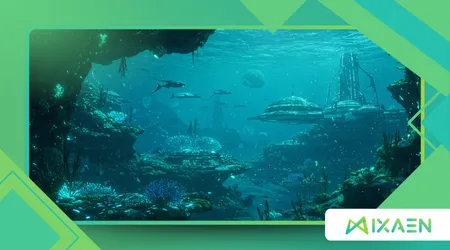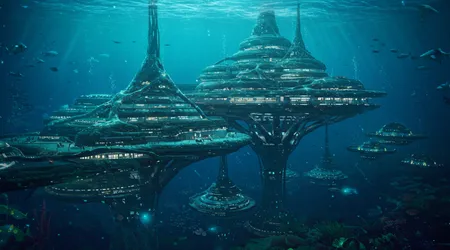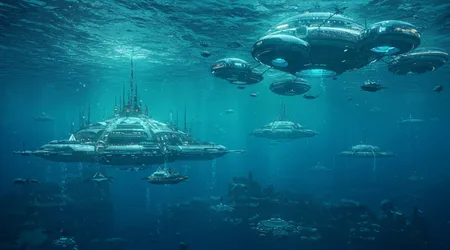Could Advanced Civilizations Live on Water Worlds

The question, Could Advanced Civilizations Live on Water Worlds, transcends mere scientific curiosity; it challenges our Earth-centric view of development and intelligence.
Anúncios
For decades, the search for extraterrestrial life has focused on “Goldilocks” planets rocky worlds nestled perfectly within the habitable zone, much like our own.
Yet, emerging exoplanet research, especially observations from the James Webb Space Telescope (JWST), reveals a potentially far more common reality: worlds entirely covered by deep, global oceans, often beneath hydrogen-rich atmospheres.
These so-called “Hycean” or “Water Worlds” represent a radical divergence from our terrestrial norm.
While liquid water is the undisputed engine of life as we know it, the technological and philosophical challenges of building a civilization entirely submerged or floating present an extraordinary thought experiment.
Anúncios
We must explore how deep-sea environments affect resource access, energy production, and the fundamental drivers of technological advancement, a vital consideration when asking Could Advanced Civilizations Live on Water Worlds.
What are the Unique Challenges of the Water World Environment?
The continuous, deep ocean setting fundamentally alters the developmental path for any potential advanced civilization.
Why is Metallurgy and Fire Difficult Underwater?
The cornerstone of Earth’s industrial revolution was the manipulation of metals, which requires intense heat and fire. Submerged civilizations face monumental engineering hurdles to replicate this on a planet entirely covered by water.
Developing smelting and forging techniques without ready access to dry, high-temperature environments seems nearly impossible.
Imagine the energy cost and material stress of creating a pressurized underwater dry-forge, a necessary tool for such a civilization.
Furthermore, accessing deep mineral resources typically found in continental crusts poses a unique logistical and geological challenge, greatly influencing the technological trajectory of societies seeking to answer Could Advanced Civilizations Live on Water Worlds.
++ Why Red Dwarf Stars Are Promising—and Problematic—for Life
How Does the Absence of Land Inhibit Astronomy?
Advanced civilizations define themselves, in part, by their ability to study and understand the cosmos. The complete absence of dry land makes building traditional optical or radio telescopes impossible.
Dense water scatters light and radio waves, rendering direct celestial observation useless from below the surface.
Any water-world astronomy would rely on advanced neutrino detectors or gravitational wave sensors, requiring radically different technological paths.
This inability to look outward might fundamentally change the civilization’s philosophical focus, shifting their attention entirely to the dynamics of the deep ocean itself.

What Technological Workarounds Might Water Worlds Develop?
If advanced life exists, they must have overcome these colossal environmental constraints with ingenious solutions we have yet to imagine.
How Do They Harness Energy and Resources?
Energy access drives technological development, and a water world presents unique, but potentially abundant, power sources.
Also read: Frozen water around young sun-like stars: A sign of planet formation and potential habitability
Leveraging Hydrothermal Vents and Geothermal Power
The geological forces of a planet, even beneath a deep ocean, remain powerful. Civilizations might tap into seafloor hydrothermal vents, harnessing geothermal heat and chemical energy directly.
These vents provide concentrated, high-energy gradients, fueling a technological society without combustion. Their cities might cluster around these energetic oases, a stark contrast to our land-based power grids.
The ability to safely and sustainably exploit these violent, localized energy sources would mark a major engineering feat, directly addressing a key limitation when considering Could Advanced Civilizations Live on Water Worlds.
Read more: TWA-7b: The young Saturn-mass exoplanet was directly photographed
Mastering Acoustic and Hydrodynamic Communication
Electromagnetic waves, like radio, fail in the deep ocean, but sound travels beautifully. An advanced water-world society would likely master the use of acoustics for communication, sensing, and navigation across global scales.
They might use low-frequency sound channels as a planetary ‘internet,’ sending vast amounts of compressed data across the global ocean.
This mastery of hydrodynamics would replace our expertise in electromagnetism, offering a viable alternative.
This acoustic technology would be inherently high-bandwidth and remarkably resilient, an essential innovation for any civilization asking Could Advanced Civilizations Live on Water Worlds.
The Evolutionary and Societal Structure

The environment shapes not only technology but also the very structure and philosophy of a society.
What Evolutionary Paths Define Their Intelligence?
Evolution on a water world would favor different traits than those prioritized on a continental surface.
The Dominance of Fluid Motion and Sensing
A civilization evolving in three-dimensional liquid space might lack the concept of rigid structures or even the need for hands, as we define them.
They might rely on sophisticated bio-sonar, electroreception, or fine-tuned control of water currents for interaction and manipulation.
Their architecture could consist of dynamic, biologically grown, or self-assembling structures that respond to current and pressure. This emphasis on fluid mechanics over solid construction suggests a radically different material science.
Their entire societal structure might reflect the flow and connectivity of the ocean itself, fostering communal, highly coordinated behavior, which helps us imagine Could Advanced Civilizations Live on Water Worlds.
Instead of nuclear power plants, a water-world civilization develops vast, flexible bio-luminescent farms that use chemosynthesis and pressure differentials to generate cool, stable electrical power, distributing it through deep-sea geothermal cables.
The Potential Lack of Plate Tectonics and Its Impact
Many of the water worlds identified, particularly the ‘Hycean’ candidates, are larger than Earth and may lack the necessary conditions for plate tectonics.
Plate tectonics is crucial on Earth for recycling carbon and regulating the climate over geological timescales.
If plate tectonics is absent, the biosphere’s lifespan could be significantly shorter, or the deep ocean could become chemically stagnant, posing a risk to the long-term sustainability of the advanced civilization. This geological difference is a major limiting factor often overlooked.
A 2025 study on exoplanet density, published in The Astrophysical Journal Letters, suggested that many sub-Neptune exoplanets previously classified as water worlds are, in fact, unlikely to be fully water-dominated, challenging the abundance of these specific environments.
The findings indicate that chemical interactions between the magma ocean and the hydrogen atmosphere during formation prevent the accumulation of massive water layers, focusing our search on smaller, more Earth-like worlds.
Final Thoughts: The Search Re-calibrated
The possibility of Could Advanced Civilizations Live on Water Worlds forces us to expand our technological imagination far beyond terrestrial templates.
Their technology would be defined by acoustics, pressure tolerance, and energy capture from geothermal or chemical gradients, rather than fire and flight.
The Great Filter Re-imagined
If the ‘Great Filter’ the reason we haven’t found other advanced civilizations is technological, perhaps the difficulty of industrializing in a water environment is the filter itself.
The inability to easily access and manipulate metals, or to launch objects into space without immense hydrostatic pressure, presents a staggering hurdle.
Yet, considering the sheer number of likely ocean worlds confirmed by observatories like JWST, the probability of complex, intelligent life having evolved there remains high.
Maybe our radio technology is simply too crude to detect their acoustic signals. Instead of rockets, a water-world civilization develops extremely durable, highly efficient pressure vessels.
They use tidal power and massive underwater electromagnetic coils to accelerate these vessels to near-orbital speeds before they breach the atmosphere for space travel.
Comparative Viability: Terrestrial vs. Water World Civilizations
| Feature | Earth (Terrestrial/Ocean Mix) | Water Worlds (Global Ocean) | Limiting Factor |
| Primary Energy Source | Combustion, Nuclear, Solar (Land-based) | Geothermal, Hydrothermal Vents, Pressure Gradients | Access to fire/High-temperature processes |
| Foundation of Technology | Metallurgy, Electromagnetism, Rigid Construction | Hydrodynamics, Acoustics, Bio-Engineering | Absence of dry land/Scattering of EM waves |
| Access to Space | Rockets launched from low-pressure surface | Extreme pressure vessels/Sub-surface launch facilities | Energy required to overcome hydrostatic pressure |
| Societal Structure | Hierarchical, resource-based territorialism (land) | Fluid, communal, resource sharing (vent oases) | Continental fragmentation/Limited mobility |
Conclusion: A Universe of Possibilities
The existence of numerous water worlds challenges the traditional scope of SETI research, compelling us to consider radically different technosignatures.
The universe is likely rich in oceans, and if life is there, advanced solutions must exist, even if they bear no resemblance to our industrial age.
The final answer to Could Advanced Civilizations Live on Water Worlds probably rests on a technological foundation of hydrodynamics and geothermal power, not fire and stone. Our duty now is to listen with a broader ear.
Do we need to develop entirely new sensory technology to detect civilizations that communicate only through the silent, sonic pulses of the deep cosmic ocean?
Share your thoughts on the kind of “technosignatures” we should be searching for on these mysterious ocean worlds in the comments.
Frequently Asked Questions (FAQ)
Q: What is a “Water World” or “Hycean” Planet?
A: A water world is an exoplanet where water makes up a significant mass fraction, potentially forming a global ocean dozens or even hundreds of kilometers deep.
Hycean planets are a newly theorized sub-class: warm, ocean-covered planets with dense, hydrogen-rich atmospheres.
Q: Why is a hydrogen-rich atmosphere a problem for life?
A: While hydrogen is not inherently toxic, a very thick hydrogen atmosphere creates immense pressure and greenhouse effects, which could make the deep ocean too hot or too pressurized for life as we know it, even for advanced forms.
Q: If a civilization is underwater, how can we detect it?
A: We would likely need to search for technosignatures that are not radio waves. This might include structured atmospheric pollutants (like fluorocarbons from industrial processes), massive thermal anomalies near hydrothermal vents, or even large, artificial structures that subtly alter the gravitational field of the planet.
